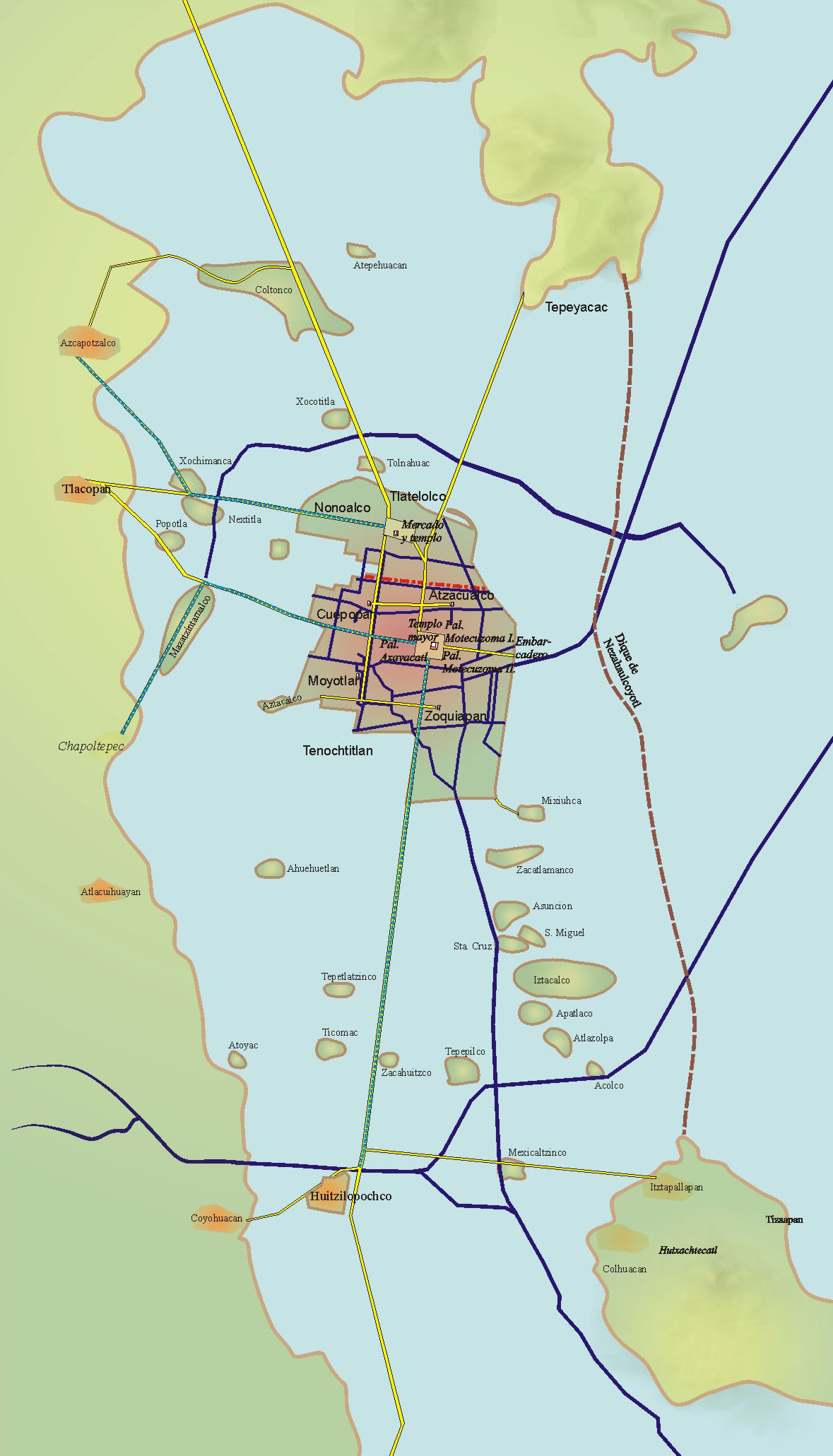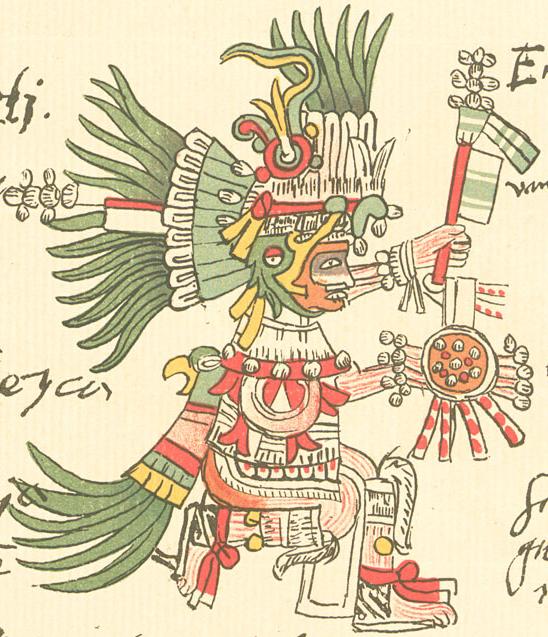|
List Of Tlatoque Of Tenochtitlan
This is a list of Mesoamerican rulers of the ''altepetl'' of Tenochtitlan (modern Mexico City) from its foundation in 1325 until the end of the line of indigenous rulers. From onwards, the rulers of Tenochtitlan were monarchs and used the title ''tlatoani''. From 1427 to 1521, the ''tlatoque'' of Tenochtitlan were alongside those of the cities Tetzcoco and Tlacopan the leaders of the powerful Triple Alliance, commonly known as the Aztec Empire. The rulers of Tenochtitlan were always pre-eminent and gradually transitioned into the sole rulers of the empire; under either Tizoc (1481–1486) or Ahuitzotl (1486–1502), the ''tlatoque'' of Tenochtitlan assumed the grander title ''huehuetlatoani'' ("supreme ''tlatoani''") to indicate their superiority over the other ''tlatoque'' in the alliance. The evolution into full autocracy was finished by 1502, when Moctezuma II was elected as ''huehuetlatoani'' of Tenochtitlan without the traditional input from Tetzcoco and Tlacopan. In 1521, ... [...More Info...] [...Related Items...] OR: [Wikipedia] [Google] [Baidu] |
Tenochtitlan
, also known as Mexico-Tenochtitlan, was a large Mexican in what is now the historic center of Mexico City. The exact date of the founding of the city is unclear, but the date 13 March 1325 was chosen in 1925 to celebrate the 600th anniversary of the city. The city was built on an island in what was then Lake Texcoco in the Valley of Mexico. The city was the capital of the expanding Aztec Empire in the 15th century until it was Fall of Tenochtitlan, captured by the Tlaxcaltec and the Spanish in 1521. At its peak, it was the largest city-state, city in the pre-Columbian Americas. It subsequently became a ''Municipalities of Mexico, cabecera'' of the Viceroyalty of New Spain. Today, the ruins of are in the historic center of the Mexican capital. The World Heritage Site of contains what remains of the geography (water, boats, Chinampa, floating gardens) of the Mexica capital. was one of two Mexica (city-states or Polity, polities) on the island, the other being . Etymol ... [...More Info...] [...Related Items...] OR: [Wikipedia] [Google] [Baidu] |
Mexica
The Mexica (Nahuatl: ; singular ) are a Nahuatl-speaking people of the Valley of Mexico who were the rulers of the Triple Alliance, more commonly referred to as the Aztec Empire. The Mexica established Tenochtitlan, a settlement on an island in Lake Texcoco, in 1325. A dissident group in Tenochtitlan separated and founded the settlement of Tlatelolco with its own dynastic lineage. In 1521, their empire was overthrown by an alliance of Spanish conquistadors and rival indigenous nations, most prominently the Tlaxcaltecs. The Mexica were subjugated under the Spanish Empire for 300 years, until the Mexican War of Independence overthrew Spanish dominion in 1821. Today, descendants of the Mexica and other Aztecs are among the Nahua people of Mexico. Since 1810, the broader term ''Aztec'' is often used to describe the Mexica. When a distinction is made, Mexica are one (dominant) group within the Aztecs. Names The ''Mexica'' are eponymous of the place name Mexico (''Mēxihco ... [...More Info...] [...Related Items...] OR: [Wikipedia] [Google] [Baidu] |
Martyr
A martyr (, ''mártys'', 'witness' Word stem, stem , ''martyr-'') is someone who suffers persecution and death for advocating, renouncing, or refusing to renounce or advocate, a religious belief or other cause as demanded by an external party. In colloquial usage, the term can also refer to any person who suffers a significant consequence in protest or support of a cause. In the martyrdom narrative of the remembering community, this refusal to comply with the presented demands results in the punishment or execution of an individual by an oppressor. Accordingly, the status of the 'martyr' can be considered a posthumous title as a reward for those who are considered worthy of the concept of martyrdom by the living, regardless of any attempts by the deceased to control how they will be remembered in advance. Insofar, the martyr is a relational figure of a society's boundary work that is produced by collective memory. Originally applied only to those who suffered for their religious b ... [...More Info...] [...Related Items...] OR: [Wikipedia] [Google] [Baidu] |
Chimalpopoca
Chimalpopoca ( for "smoking shield," ) or Chīmalpopōcatzin (1397–1427) was the third Emperor of Tenochtitlan (1417–1427). Biography Chimalpopoca was born to the Emperor Huitzilihuitl and Queen Ayauhcihuatl. Rule Chimalpopoca was crowned in 1417 (some sources say 1416 or 1418), at approximately 20 years old. At that time, Tenochtitlan was a tributary of the Tepanec city of Azcapotzalco, which was ruled by his grandfather Tezozomoc. This alliance, and the Mexicas' position within it, was strengthened by Tenochtitlan's loyalty during Tezozomoc's 1418 war with Ixtlilxochitl I of Texcoco. The conquered city was granted to Tenochtitlan as a tributary. Nezahualcoyotl, displaced prince of Texcoco, was living in the mountains. Chimalpopoca interceded with Tezozomoc on his behalf, and Tezozomoc agreed to allow Netzahualcoyotl to live in Tenochtitlan under his protection. In 1426 Tezozómoc assisted Chimalpopoca in the construction of a new aqueduct. This aqueduct was of ... [...More Info...] [...Related Items...] OR: [Wikipedia] [Google] [Baidu] |
Huitzilihuitl
Huitzilihuitl () or Huitzilihuitzin (Nahuatl language; English: ''Hummingbird Feather'') (1370s – ''ca.'' 1417) was the second ''Tlatoani'' or king of Tenochtitlan. According to the Codex Chimalpahin, he reigned from 1390 to 1415, according to the Codex Aubin, he reigned from 1396 to 1417 and according to the Codex Chimalpopoca, he reigned from 1403 to 1417. Biography Family and childhood Huitzilíhuitl was born in Tenochtitlan, and was the son of Acamapichtli, first ''tlatoani'' of the Mexica, and Queen Tezcatlan Miyahuatzin, and had a half-brother Itzcoatl. His maternal grandfather was Acacitli. Only 16 years old when his father died, Huitzilihuitl was elected by the principal chiefs, warriors and priests of the city to replace him. At that time, the Mexica were tributaries of the Tepanec city-state of Azcapotzalco. Reign Huitzilíhuitl, a good politician, continued the policies of his father, seeking alliances with his neighbors. He founded the Royal Council or ''T ... [...More Info...] [...Related Items...] OR: [Wikipedia] [Google] [Baidu] |
Azcapotzalco
Azcapotzalco ( ; ; from ''wikt:azcapotzalli, āzcapōtzalli'' “anthill” + ''wikt:-co, -co'' “place”; literally, “In the place of the anthills”) is a Boroughs of Mexico City, borough (''demarcación territorial'') in Mexico City. Azcapotzalco is in the northwestern part of Mexico City. The town began in the pre-Hispanic era and was the seat of the Tepanec dominion until the Aztec Triple Alliance overthrew it. After that it was a rural farming area becoming part of the Federal District of Mexico City in the mid-19th century. In the 20th century the area was engulfed by the urban sprawl of Mexico City. Today it is 100% urbanized and is a center of industry. Geography The municipality of Azcapotzalco is in the Valley of Mexico with its eastern half on the lakebed of the former Lake Texcoco and the west on more solid ground. The historic center is on the former shoreline of this lake. The average altitude is 2240 meters above sea level. Politically, the municipality exten ... [...More Info...] [...Related Items...] OR: [Wikipedia] [Google] [Baidu] |
Tezozomoc (Azcapotzalco)
Tezozomoc Yacateteltetl (also Tezozómoc, Tezozomoctli, Tezozomoctzin; c. 1320 – 1426), was a Tepanec leader who ruled the ''altepetl'' (ethnic state) of Azcapotzalco (altepetl), Azcapotzalco from the year 1353 or Aztec calendar, Five Reed (1367) or Aztec calendar, Eight Rabbit (1370) until his death in the year Aztec calendar, Twelve Rabbit (1426). Histories written down in the early colonial period portray Tezozomoc as a military and political genius who oversaw an expansion of Tepanec influence, bringing about Azcapotzalco's dominance in the Valley of Mexico and beyond. Biography Tezozomoc was a son of Acolnahuacatzin and Cuetlaxochitzin. He is described by Fernando de Alva Cortés Ixtlilxochitl as a tyrant and: "the most cruel man who ever lived, proud, warlike and domineering. And he was so old, according to what appears in the histories, and to what elderly princes have told me, that they carried him about like a child swathed in feathers and soft skins; they always took ... [...More Info...] [...Related Items...] OR: [Wikipedia] [Google] [Baidu] |
Toltec
The Toltec culture () was a Pre-Columbian era, pre-Columbian Mesoamerican culture that ruled a state centered in Tula (Mesoamerican site), Tula, Hidalgo (state), Hidalgo, Mexico, during the Epiclassic and the early Post-Classic period of Mesoamerican chronology, reaching prominence from 950 to 1150 CE. The later Aztec culture considered the Toltec to be their intellectual and cultural predecessors and described Toltec culture emanating from Tollan, ''Tōllān'' (Nahuatl language, Nahuatl for Tula) as the epitome of civilization. In the Nahuatl language the word ''Tōltēkatl'' (singular) or ''Tōltēkah'' (plural) came to take on the meaning "artisan". The Aztec oral tradition, oral and pictographic tradition also described the history of the Toltec Empire, giving lists of rulers and their exploits. Modern scholars debate whether the Aztec narratives of Toltec history should be given credence as descriptions of actual historical events. While all scholars acknowledge that the ... [...More Info...] [...Related Items...] OR: [Wikipedia] [Google] [Baidu] |
Codex Mendoza Folio 2v Detail
The codex (: codices ) was the historical ancestor format of the modern book. Technically, the vast majority of modern books use the codex format of a stack of pages Bookbinding, bound at one edge, along the side of the text. But the term ''codex'' is now reserved for older manuscript books, which mostly used sheets of vellum, parchment, or papyrus, rather than paper. By convention, the term is also used for any Aztec codex (although the earlier examples do not actually use the codex format), Maya codices and other Pre-Columbian era, pre-Columbian manuscripts. Library practices have led to many European manuscripts having "codex" as part of their usual name, as with the Codex Gigas, while most do not. Modern books are divided into paperback (or softback) and those bound with stiff boards, called hardbacks. Elaborate historical bindings are called treasure bindings. At least in the Western world, the main alternative to the paged codex format for a long document was the continuo ... [...More Info...] [...Related Items...] OR: [Wikipedia] [Google] [Baidu] |






